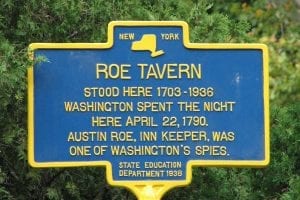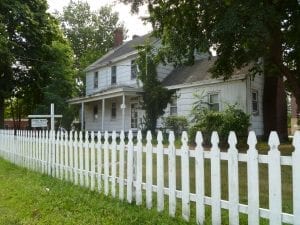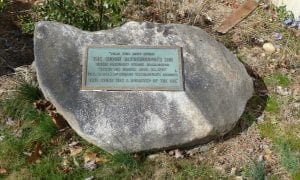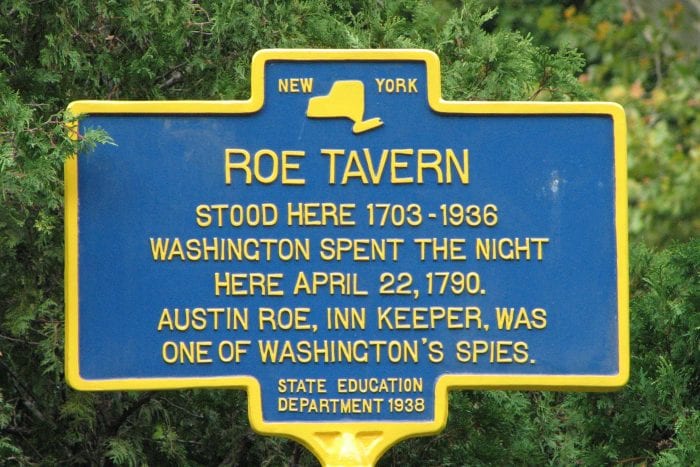By Corey Geske
Two hundred thirty years ago, George Washington planned a tour of Long Island during the third week of April 1790 to thank the members of the Culper Spy Ring of Setauket, whose courage and resourcefulness played a significant role in helping to win the American Revolution.
The First President chose to begin his tour on April 19, the 15th anniversary of the battles of Lexington and Concord, the first military encounters of that war, when thirteen colonies fought to become independent from the British empire. Washington’s Long Island tour marked that day, which since 1894 has been known as Patriots’ Day. More recently, in 2017, the work of the Culper Spy Ring was recognized by the New York State Legislature and commemorative Spy Trail signs were installed by the North Shore Promotion Alliance and the Ward Melville Heritage Organization.
Washington planned to set out from New York City, then the capital of the young American nation, on Monday April 19, 1790, but weather delayed him for a day. After touring the South Shore, he headed north to the Coram area and then west to Setauket, arriving on April 22, nearly nine years to the day (April 23, 1781) when his chief spy Abraham Woodhull, code name Samuel Culper, Sr., of Setauket, wrote to him that his spy ring faced imminent danger.
Washington’s itinerary demonstrates a keen sense of place timed to show his personal appreciation for how important the intelligence from Setauket was to the winning of the war, information that helped save West Point in 1780 and the French navy at Newport, RI, so it could sail south for the ultimate American victory at Yorktown, VA.

On April 22, 1790, Washington recorded in his diary “. . . thence to Setakit . . . to the House of a Captn. Roe which is tolerably dect.[decent] with obliging people in it.” He arrived at Roe Tavern with an entourage led by Selah Strong, a Patriot imprisoned by the British during the Revolution, the grandson of the builder of the 1703 home that became part of the tavern; and husband of Anna (Nancy) Smith Strong, a key member of the Culper Ring.
The President slept at Roe Tavern run by Captain Austin Roe, a critical courier and messenger for the ring, who frequently rode from Setauket to New York City to deliver information vital to Washington. It is a tribute to Roe and the Setauket-based ring, that Washington mapped his Long Island tour from the South to North Shore to travel from Setauket west to New York, as Roe had done.
On Friday morning, April 23, 1790, Washington “left Roes, and baited the horses at Smiths Town, at a Widow Blydenbergs – a decent House 10 Miles from Setalket . . .” The stone doorstep, which still exists, of the long-gone Widow Blydenburgh’s Tavern, may well have supported Washington’s footsteps and serves as a reminder of Jonathan Harrington of Lexington, who, fatally shot by the British, crawled back to the doorstep of his home fronting the common to die at the feet of his wife.

Washington’s carriage passed by what is now known as the Arthur House, circa 1752, on West Main Street, Smithtown, the future home of Mary Woodhull Arthur, daughter of Abraham Woodhull, the critical correspondent in the spy network set up by Major Benjamin Tallmadge. Born in Setauket, Tallmadge relied upon his boyhood friends to supply intelligence at great risk and was Washington’s spymaster and director of military intelligence.
In 1781, Robert Townsend of Oyster Bay and New York City, code name Culper Junior, could not trust to writing the news of the ring’s probable discovery by the British and risked the journey from New York City to personally inform Woodhull in Setauket. Immediately thereafter, Woodhull wrote Washington on April 23, 1781: “I had a visit from C. Junr. and am sorry to inform you that he will not write any more on any account whatever.”
In this darkest of moments, the Culper Spy Ring faced the ultimate challenge of surviving and finding another way to convey information to Washington knowing that British spy William Heron, code name ‘Hiram the Spy,’ had already reported to British General Sir Henry Clinton that “Private dispatches are frequently sent from New York to the Chieftain here (George Washington) by some traitors. They come by the way of Setalket, where a certain Brewster receives them at, or near, a certain womans,” that is to say Anna Strong signaled Woodhull, via the arrangement of clothes on her clothesline, when Captain Caleb Brewster arrived in his whaleboat to carry messages across Long Island Sound.

In 1789 during his first year as the unanimously elected First President, Washington decided he would visit each state to determine their feelings about the new United States as a nation; and traveled to New England from New York City through Connecticut to New Hampshire. He completed his mission with a Southern Tour in 1791.
During a pandemic, as we mark the 245th anniversary of Patriots’ Day and the 230th anniversary of Washington’s 1790 tour of Long Island, let us remember the future First President was said to have been seen on his knees at Valley Forge praying as the American army, outnumbered by the enemy, starved, froze and faced the scourge of smallpox, a devastating virus that thinned the ranks of his army and put Boston into lockdown.
Facing a situation akin to what we face today, Washington established isolation hospitals in New York to control the epidemic – while the ‘cordon sanitaire’ that worked in Europe against the plague was reinstated in North America to control the smallpox virus.
During the British occupation of New York, nearly 11,000 American patriots died on British prison ships in Wallabout Bay near the present Brooklyn Navy Yard, many succumbing to the disease. These ‘martyrs’ included the woman who historian Morton Pennypacker believed to be the mother of Robert Townsend’s son. It is a staggering number brought home by this past month’s coronavirus losses.
Historic preservation is important: it reminds us that others, too, have faced crises, and that there were many challenges to overcome to win the American Revolution.
About the author: Independent Historian Corey Geske of Smithtown proposed a National Register Historic District for downtown Smithtown in early 2017, prepared the report resulting in the Smithtown Bull being determined Eligible for the NR (2018) and wrote the successful nomination for recent listing on the National Register of Historic Places of the Byzantine Catholic Church of the Resurrection (1929) designed by Henry J. McGill and Talbot F. Hamlin, and its Rectory, the former Fred and Annie Wagner Residence (1912) designed by Gustav Stickley.
Photos courtesy of Corey Geske





